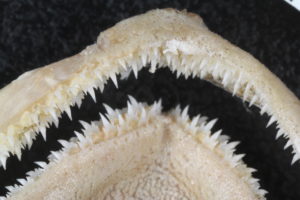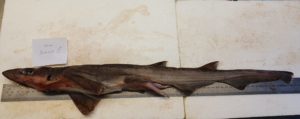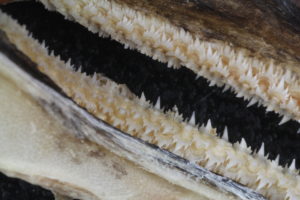Hello! My name is Renate Andersen and i’m in my 6th semester on my bachelor’s in biology. I am very interested in the ocean and almost everything about it so my goal is to take a master’s in marine biology. Sharks is what fascinates me the most in all the animal kingdom, we know so little about them, yet they play a huge part in the food chain. This semester I work with two German scientists who works with shark fossil teeth.
Background:
The identification of dental variations is very important for the correct assignment of fossil shark teeth in general, as single fossil teeth may contain information on the sex, former size and life stage of its former bearer. However, this depends on the analysis of variation in appearance within a species, in living shark species. This project is a contribution to identify potential different traits and variations in the blackmouth catshark (Galeus melastomus), which will add valuable information for the correct identification of fossil forms. The jaw only consists of cartilage which does not fossil well, because of that the teeth is the only thing we can study from old living species and extinct species.

Figure 1: Terminology used to describe the position of teeth within the jaw and tooth files (Jambura et al., 2018)
A shark jaw is divided into four parts, the lower and upper jaw which again consists of two parts (as seen in Figure 1A). Where the two parts are fused together is called the symphysis (1B) and when teeth are counted, they have to be counted from the symphysis and backwards. The fused joint is also slightly flexible so sharks can narrow or widen their jaw. In the symphysis there can sometimes appear a symphyseal tooth, which is placed directly on the joint (Figure 2). This is a misplacement but is studied because the teeth is somewhat special and does not occur too often. There might also be variances in occurrence between species, upper- and lower jaw and sexes, but this is not yet known. The teeth can vary a lot between species but some species have teeth with cusps, which can be described as multiple spikes on a tooth (Figure 3 and 4).

Figure 3: Photo of upper and lower jaw of a G. melastomus taken with a magnifying camera (original photo).
Method:
The blackmouth catsharks I’m currently working on got caught as bycatch by a bio102 class out on a field course. In the lab I started with measuring them as well as register important info as sex and life stage, then I dissect out the jaws and dry them in a drying cabinet (Figure 5 and 6).
When all the jaws are properly dried I have to study the jaws under a microscope, the teeth can be very small on the youngest sharks so the microscope is a must. While studying the jaws I have to count the number of teeth in each section of the jaw, count the rows in function, look for symphyseal teeth and count the number of cusps on each tooth. The jaws is also individually photographed from all angles with the university’s magnifying camera (figure 8).
Current status:
Right now I’m in the middle of the time consuming task of counting the teeth, as this shark can have around 40 teeth in one row in only one of the four parts of the jaw it is a lot. Soon we will dissolve some of the jaws in acid so that only the teeth will remain, since the jaw consists of cartilage they are easily dissolvable. When we have the single teeth ready they will be measured and photographed as well. When I have all the numbers ready I have to start with the statistical analysis with R. Even though I think R and statistics is difficult I’m excited to see the finished statistics that will answer some of our theories.
Thank you for reading!
-Renate






Hjelpes meg for en tanngard! Skumle og vakre på en gang. Artig navn på bloggen din, og særlig fordi disse dataene jo også blir litt sånn BIO 2.0 – fisket av studenter og analysert av studenter! Spent på å se resultatene!
E litt teknisk kommentar – veldig bra at du oppgir kilder på bildene du bruker!